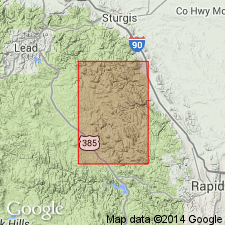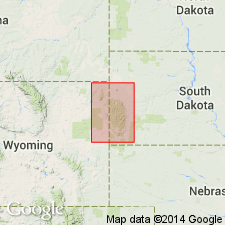
- Usage in publication:
-
- Roberts Draw Limestone*
- Modifications:
-
- Named
- Dominant lithology:
-
- Conglomerate
- Slate
- Limestone
- AAPG geologic province:
-
- Midcontinent region
Summary:
Named for exposures (its type locality) in Roberts Draw, NW1/4 sec 34, T3N, R5E, Lawrence Co, SD in the Midcontinent region. Occurs in linear exposures in central-west to central-south part of area extending east into Meade Co and south into Pennington Co. Is younger than the middle Precambrian intrusive metagabbro and older than the middle Precambrian Buck Mountain Quartzite (new). Was included as part of the Estes System by Runner (1934). Consists of: 1) basal conglomerate (locally present); 2) black slate and graywacke beneath a limestone (locally); 3) buff-weathering gray siliceous limestone; and 4) black and gray pelitic slate above limestone (locally). Of middle Precambrian age.
Source: GNU records (USGS DDS-6; Denver GNULEX).

- Usage in publication:
-
- Roberts Draw Formation*
- Modifications:
-
- Age modified
- AAPG geologic province:
-
- Midcontinent region
Summary:
Conformably overlies the Early Proterozoic Estes Formation. Assigned an Early Proterozoic age; thought to be about 2.0 Ga. Mapped (Pl. 1) with units Xgb and Xd. Geologic map.
Source: GNU records (USGS DDS-6; Denver GNULEX).
For more information, please contact Nancy Stamm, Geologic Names Committee Secretary.
Asterisk (*) indicates published by U.S. Geological Survey authors.
"No current usage" (†) implies that a name has been abandoned or has fallen into disuse. Former usage and, if known, replacement name given in parentheses ( ).
Slash (/) indicates name conflicts with nomenclatural guidelines (CSN, 1933; ACSN, 1961, 1970; NACSN, 1983, 2005, 2021). May be explained within brackets ([ ]).

